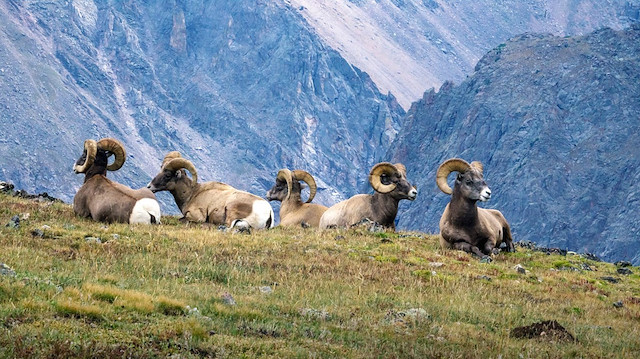
Montane ecosystems, which host unique habitats, endemic wildlife species and also play a crucial role in human life, are under a number of threats.
In 2003, the UN General Assembly designated Dec. 11 as "International Mountain Day" in order to encourage the international community to organize events to stress the importance of sustainable mountain development.
"The distribution of the mountains on Earth, in which 90% of them stay along linear lines, demonstrates that mountains are not a land form that randomly occurred," Abdurrahman Dokuz, an expert on geology at Turkey's Gumushane University, told Anadolu Agency.
Defining mountains as terrestrial areas with a high and sloping topography compared to the areas around them, Dokuz said the four main types of mountains are folded or complex, fault-block, volcanic and upwarped.
"Folded mountains, which are also known as compressive mountain belts, rise along the boundaries of the continental lithosphere plates approaching each other...the Alpine-Himalayan Belt, Ural Mountains, Appalachians and Caledonites are the most beautiful examples of them," he said.
Regarding fault-block mountains, Dokuz said they develop along the boundary of the plate, and since the continental lithosphere plate tried to extend along these lines, it is eventually divided into two.
"Volcanic mountains are mountains that develop due to volcanism, which is an earth phenomenon that occurs when molten rock material reaches the earth as lava or superheated rock particles,” he said.
He said the Hawaiian islands are examples of linearly extending volcanic mountains on the oceanic crust while the Ararat, Argaeus, Hasandag and Nemrut ve Suphan mountains are examples of individual volcanic mountains in Turkey, and beneath Yellowstone National Park in the U.S. is a ‘supervolcano’ with a caldera or large volcanic crater about 60 kilometers (37 miles) in diameter.
Touching on the final type, he said upwarped mountains develop independently of the plate boundaries and are the hilly areas that arise as a result of erosion of high plateaus by the valleys.
Referring to the importance of mountains as key sources of fresh water, he said although three quarters of the world's surface is covered with water, only 2.5% of the water reserve is fresh water, which mostly exists in the polar regions and in the form of glaciers on the mountains near the pole.
"Compared to coastal areas, the temperature is up to 20 degrees lower, which allows the snow at the peaks to melt slowly. Thus, groundwater, streams and natural springs can be fed during the dry season with little or no rainfall," he added.
- 'Mountains affect climate, are affected by climate change'
"Montane ecosystems that affect the climate due to their features, such as height, have become affected by the climate as a result of global climate change," Ahmet Emre Kutukcu, a wildlife expert from World Wildlife Fund (WWF) Turkey, told Anadolu Agency.
Saying that water resources in mountains are in danger, Kutukcu noted that the most endangered species which are affected by climate change are living in the highlands and island ecosystems.
Mentioning that half of the 35 biodiversity hotspots around the world exist in montane ecosystems, he said these ecosystems are very sensitive, have unique biodiversity and are home to large endemic species.
"Many water sources come from the mountains, as the mountains contain the presence of permanent snow masses and glaciers. So in this sense, high mountains or montane ecosystems are very important" for human beings as well as wildlife species.
Touching on the main threats that mountains face along with climate change, Kutukcu noted that excessive husbandry activities that cause erosion by disrupting the structure of the soil can be considered one of the human-induced negative effects.
Noting that most mining activities are conducted in montane ecosystems, he said activities such as quarrying and gold mining are a major threat as they can affect the biodiversity of the region as well as people's water resources.
"The construction of roads paves the way easily for people to reach sensitive mountain ecosystems, which means more poaching, pollution and waste," he said, referring to urbanization as another threat.
He added that poaching is another threat to montane ecosystems, especially to mammals such as wild goats, chamois and leopards as well as wood grouses, partridges and bearded vultures living in these habitats.
"The degradation of glacial and permanent snow structure in high mountain ecosystems decreases in the drought-precipitation balance and the formation of factors that adversely affect the climate increases the wildfire risk," he said, referring to the fact that degradation of the geological structure of the mountains affects food and water resources and in turn people.
He said the high mountain ecosystem consists of areas beginning with a forest belt at the bottom, then alpine belt and continuing through meadow and shrubland areas, and at the highest level, there is permanent snow mass which contains moss and thorns.
"The distortion between these sections therefore cripples the entire ecosystem," he noted.
In order to protect mountains, he first suggested that it is necessary to develop and implement legal regulations, and ecological and cultural aspects should be prioritized rather than the financial income from mining activities and people should be prevented from engaging in activities in conflict with wildlife such as poaching.
He added that the promotion of ecological tourism and beekeeping activities without causing the migration of people to a high ecosystem and without damaging the biological diversity could also be positive steps towards preserving mountains.














